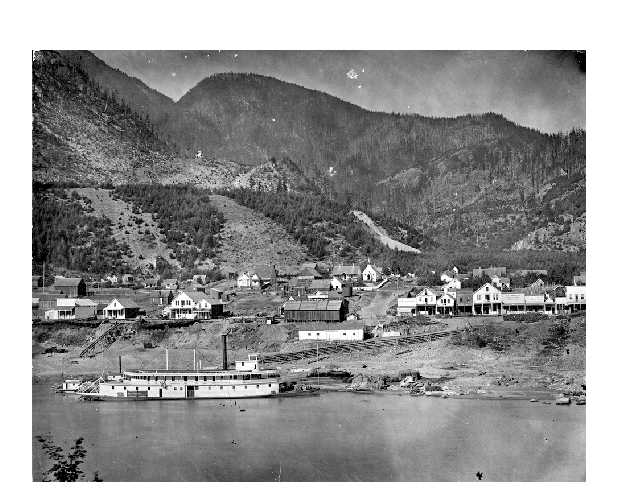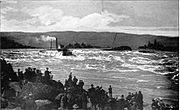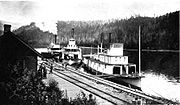
James W. Troup (steamboat captain)
Encyclopedia

Canadian Pacific Railway
The Canadian Pacific Railway , formerly also known as CP Rail between 1968 and 1996, is a historic Canadian Class I railway founded in 1881 and now operated by Canadian Pacific Railway Limited, which began operations as legal owner in a corporate restructuring in 2001...
administrator and shipping pioneer.
Family
Captain James William Troup was born in Portland, Oregon in February, 1855. He was the son of Capt. Willam H. Troup, a prominent early steamboatman in the Pacific Northwest. His maternal grandfather was sailing ship Capt. John Turnball. James had a younger brother, Claud Troup (1865-1896) who was also an accomplished steamboat captain. James Troup also had a son, Roy Troup, who became a steamboat captain.Early career
Together with his father, Captain Troup built many of the early steamboats of the Columbia RiverColumbia River
The Columbia River is the largest river in the Pacific Northwest region of North America. The river rises in the Rocky Mountains of British Columbia, Canada, flows northwest and then south into the U.S. state of Washington, then turns west to form most of the border between Washington and the state...
and he went to work on the steamer Vancouver in 1872 at the age of 17.
By the age of 20 he was captain of the small propeller steamer Wasp, having served in every position from deckhand on up. Troup went to work on the Columbia river above the Cascades, for the Oregon Steam Navigation Company
Oregon Steam Navigation Company
The Oregon Steam Navigation Company was an American company incorporated in 1860 in Washington with partners J. S. Ruckle, Henry Olmstead, and J. O. Van Bergen...
holding first a position as a purser and later as master. When the first Harvest Queen, a big new steamer was built in 1878, Troup was appointed her master, even though he was only 23 years of age.
In the early 1880s, as railways started to be completed along the Columbia River
Columbia River
The Columbia River is the largest river in the Pacific Northwest region of North America. The river rises in the Rocky Mountains of British Columbia, Canada, flows northwest and then south into the U.S. state of Washington, then turns west to form most of the border between Washington and the state...
, the Oregon Railway and Navigation Company, which had bought out the O.S.N., started taking its boats off of the river to find employment for them elsewhere. This required running the rapids either at Celilo Falls
Celilo Falls
Celilo Falls was a tribal fishing area on the Columbia River, just east of the Cascade Mountains, on what is today the border between the U.S. states of Oregon and Washington...
, the Cascades, or both. In 1881, Troup ran Harvest Queen over Celilo Falls, where she was nearly wrecked, and then through the Cascades. In 1881, he also took Idaho through the Cascades.
First work in British Columbia

British Columbia
British Columbia is the westernmost of Canada's provinces and is known for its natural beauty, as reflected in its Latin motto, Splendor sine occasu . Its name was chosen by Queen Victoria in 1858...
for J. A. Mara
John Andrew Mara
John Andrew Mara was a Canadian merchant, rancher and a politician at both the provincial and federal levels....
, owner of the Peerless and Spallumcheen, two steamboats running on Kamloops
Kamloops Lake
Kamloops Lake in British Columbia, Canada is situated on the Thompson River just west of Kamloops. The lake is 1.6 km wide, 29 km long, and up to 152 m deep...
and Shuswap
Shuswap Lake
Shuswap Lake is a lake located in south-central British Columbia, Canada that drains via the Little River into Little Shuswap Lake. Little Shuswap Lake is the source of the South Thompson River, a branch of the Thompson River, a tributary of the Fraser River...
lakes and the Thompson River
Thompson River
The Thompson River is the largest tributary of the Fraser River, flowing through the south-central portion of British Columbia, Canada. The Thompson River has two main branches called the South Thompson and the North Thompson...
. He also won the trust of Captain John Irving
John Irving (steamship captain)
John Irving was a steamship captain in British Columbia, Canada. He began on the Fraser River at the age of 18 and would become one of the most famous and prosperous riverboat captains of the era...
as a skilled steamboat captain, and was placed in charge of Irving's main steamer William Irving
William Irving
William Irving may refer to:* William Irving , British Labour Co-operative MP 1945–1955* William Irving , steamship captain from Scotland, active in Oregon, Washington and British Columbia...
, named after Captain Irving's father. Irving also gave Troup command of the huge and difficult to manage sidewheeler Yosemite
Yosemite (sidewheeler)
The steamboat Yosemite operated for almost fifty years on San Francisco Bay, the Sacramento River, inland coastal waters and the lower Fraser River in British Columbia, and Puget Sound.-Design:...
on the route from Victoria to New Westminster.
Return to Oregon
He worked with John Irving and the Canadian Pacific Navigation Company until 1886, when he returned to Oregon to assume charge of the Oregon Railway and Navigation Company which was then owned by the Union Pacific. He worked in Oregon until 1892, and during this time he supervised construction of many steamboats, including the famous T.J. Potter. In 1891, Victorian was launched at Portland, OregonPortland, Oregon
Portland is a city located in the Pacific Northwest, near the confluence of the Willamette and Columbia rivers in the U.S. state of Oregon. As of the 2010 Census, it had a population of 583,776, making it the 29th most populous city in the United States...
. This ship was an extremely large vessel for one built entirely of wood. She was also underpowered, and became one of Troup's few design failures.
Run of the Hassalo through the Cascades

Hassalo (sternwheeler 1880)
The steamboat Hassalo operated from 1880 to 1898 on the Columbia River and Puget Sound. Hassalo became famous for running the Cascades of the Columbia on May 26, 1888 at a speed approaching an hour...
through the Cascades of the Columbia, covering the six miles of whitewater in just seven minutes. While other captains had come through the Cascades, and even bested Troup's time, as had Captain McNulty in the R.R. Thompson
R.R. Thompson (sternwheeler)
R.R. Thompson was a large sternwheel steamboat designed in the classic Columbia River style. She was named after Robert R. Thompson, one of the shareholders of the Oregon Steam Navigation Company the firm that built the vessel.-Design and Construction:...
a few years before, the famous run of the Hassalo was witnessed by 3,000 people and made the subject of a well-known photograph.
Steamboat operations in inland British Columbia

One of Troup's most successful designs was the steamer Rossland
Rossland (sternwheeler)
The Rossland was a sternwheel steamboat that ran on the Arrow Lakes in British Columbia. It was named after Rossland, British Columbia, once a prosperous mining town in the region.-Design and construction:...
, which Professor Turner described as the most beautiful vessel ever to run on the Arrow Lakes. Like many prestigious steamers in the Pacific Northwest, such as the Wide West and the Bailey Gatzert
Bailey Gatzert (sternwheeler)
The Bailey Gatzert was a famous sternwheel steamboat that ran on the Columbia River and Puget Sound from the 1890s to the 1920s. She was named after Bailey Gatzert, an early businessman and mayor of Seattle...
, Rosslands saloon deck deck extended clear forward to her bow, and her pilot house was placed high above the water on top of the Texas. When Mara's company was bought out by the Canadian Pacific Railway
Canadian Pacific Railway
The Canadian Pacific Railway , formerly also known as CP Rail between 1968 and 1996, is a historic Canadian Class I railway founded in 1881 and now operated by Canadian Pacific Railway Limited, which began operations as legal owner in a corporate restructuring in 2001...
, Troup continued in charge.
Sternwheelers for the Klondike
When the Klondike Gold RushKlondike Gold Rush
The Klondike Gold Rush, also called the Yukon Gold Rush, the Alaska Gold Rush and the Last Great Gold Rush, was an attempt by an estimated 100,000 people to travel to the Klondike region the Yukon in north-western Canada between 1897 and 1899 in the hope of successfully prospecting for gold...
generated a huge demand for shipping in 1898, the C.P.R. put Troup in charge of supervising steamboat construction. Troup went to Port Blakeley, Washington to supervise construction of four sternwheelers. These vessels were intended for service on the Yukon
Yukon River
The Yukon River is a major watercourse of northwestern North America. The source of the river is located in British Columbia, Canada. The next portion lies in, and gives its name to Yukon Territory. The lower half of the river lies in the U.S. state of Alaska. The river is long and empties into...
and Stikine
Stikine River
The Stikine River is a river, historically also the Stickeen River, approximately 610 km long, in northwestern British Columbia in Canada and southeastern Alaska in the United States...
rivers and were named Constantine, Walsh, Dalton, and Schwatka. Of these boats, only Schwatka made it to Alaska, and this was only in 1904. Constantine sank on the way while under tow, and Walsh and Dalton remained in Puget Sound
Puget Sound
Puget Sound is a sound in the U.S. state of Washington. It is a complex estuarine system of interconnected marine waterways and basins, with one major and one minor connection to the Strait of Juan de Fuca and the Pacific Ocean — Admiralty Inlet being the major connection and...
and the Columbia River
Columbia River
The Columbia River is the largest river in the Pacific Northwest region of North America. The river rises in the Rocky Mountains of British Columbia, Canada, flows northwest and then south into the U.S. state of Washington, then turns west to form most of the border between Washington and the state...
. Troup also supervised sternwheeler construction at False Creek, BC and Vancouver, BC. Only three of the Vancouver boats actually operated on the Stikine River, which was being boomed as the "All-Canadian" route to the Klondike gold fields. Troup then returned to the Kootenay district, where in 1901, he was made superintendent of both steamboat and rail lines.
Superintendent of Canadian Pacific Steamships
In 1901, when the C.P.R. bought John Irving's company, the Canadian Pacific Navigation Company, Troup was transferred to Victoria, B.C. to assume charge of the operation that his former employer John Irving had established:Troup's long career was closely linked with the C.P.R. from then onwards. In 1903, he was appointed Superintendent of the British Columbia Coast service of Canadian Pacific Railway
Canadian Pacific Railway
The Canadian Pacific Railway , formerly also known as CP Rail between 1968 and 1996, is a historic Canadian Class I railway founded in 1881 and now operated by Canadian Pacific Railway Limited, which began operations as legal owner in a corporate restructuring in 2001...
.
The company was engaged in many struggles over the years, such as a bitter rate war in 1909 with the Puget Sound Navigation Company
Puget Sound Navigation Company
The Puget Sound Navigation Company was founded by Joshua Green in 1913. It operated a fleet of steamboats and ferries on Puget Sound in Washington and the Georgia Strait in British Columbia...
, headed by his friend Joshua Green
Joshua Green (seaman and banker)
Joshua Green was an American sternwheeler captain, businessman, and banker. He rose from being a seaman to being the dominant figure of the Puget Sound Mosquito Fleet, then sold out his interests and became a banker...
. Both Troup and Green agreed never to discuss the rate war so that they would not become personally involved in the dispute between their companies.
Troup is credited with conceiving and building CPR's Princess fleet
Princess fleet
The Princess fleet is an eponym for the coastal vessels of the Canadian Pacific Railway in the first half of the 20th Century. The names of these small ocean liners began with the title "Princess."...
. In 1913, 10 of the 12 Princess ships in the coastal fleet had been built to the orders of Capt. Troup.
The worst blow for Captain Troup during his career with the C.P.R. was the tragic sinking of the Princess Sophia. That ship had run ashore on Vanderbilt Reef in Lynn Canal
Lynn Canal
Lynn Canal is an inlet into the mainland of southeast Alaska.Lynn Canal runs about from the inlets of the Chilkat River south to Chatham Strait and Stephens Passage...
on October 23, 1918 Though rescue vessels were at hand, it was too rough to take anyone off the Sophia, and she remained on the reef. During the night of October 25, the storm increased, and the Sophia was blown off the reef and sank, taking down with her all 343 people. The loss of the Sophia with so many people was the worst disaster in the history of the Canadian west coast and Inside Passage
Inside Passage
The Inside Passage is a coastal route for oceangoing vessels along a network of passages which weave through the islands on the Pacific coast of North America. The route extends from southeastern Alaska, in the United States, through western British Columbia, in Canada, to northwestern Washington...
shipping. It deeply affected Captain Troup, causing him a breakdown in health which took him a long time to recover from.
Last years
Captain Troup retired in August 1928. He was 73 years old, eight years past the C.P.R.'s mandatory retirement age. By this time the C.P.R. had a fleet of profitable modern steamers serving the west coast of Canada, Alaska, and running down Puget Sound, all due in great part to the work of Captain Troup. In 1929, when he was 74 years old Captain Troup made his last whitewater run when the captain of the Lewiston showed Troup the high honor of asking him to pilot her through the lower Cascades. Captain Troup died on November 30, 1931. No other man contributed more to the maritime commerce of the Pacific Northwest.Loyalty to Captain Irving
Perhaps Captain Troup's only equal in achievement and esteem was his good friend and old employer, John Irving, who lived on until 1936. Like Troup, Captain Irving had led a life of adventure and challenge, but he was an improvident man who gave away or gambled through his fortune. His only son had been killed in World War IWorld War I
World War I , which was predominantly called the World War or the Great War from its occurrence until 1939, and the First World War or World War I thereafter, was a major war centred in Europe that began on 28 July 1914 and lasted until 11 November 1918...
, and the broken-hearted Irving, well over military age, had offered to take his up place in Canada's armed forces. In later years Captain Irving was so destitute that he seemed to have no home. C.P.R. had granted Irving the right of free travel on its ships in 1901 when he sold his firm to them. With no real residence onshore, Captain Irving used his right of travel constantly, so much so that he was practically living on C.P.R.'s ships.
There might have been some question as to whether the right of travel extended so far as Captain Irving was taking it, but for so long as Captain Troup was superintendent of the C.P.R, steamships, he made sure that that Captain Irving was always welcome on every ship in the fleet. After Troup retired, his successor tried to curtail Captain Irving's travels by decreeing that passage might be free, but Irving would have to pay for meals and a berth. This edict was always ignored by the line's captains, and Captain Irving always had a cabin and was welcome at every captain's table, as Captain Troup had wished it.

